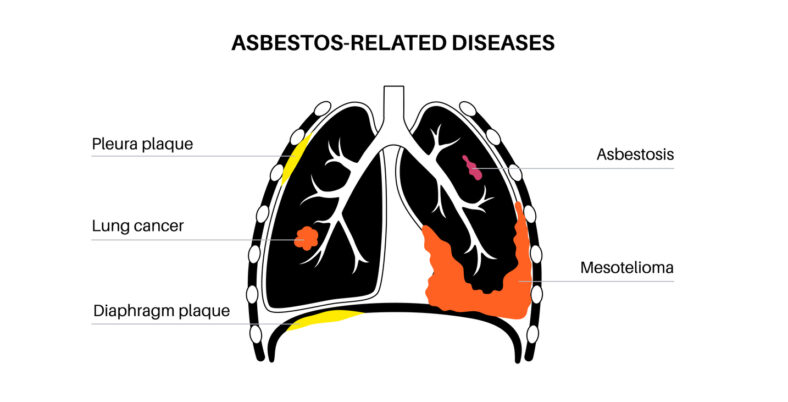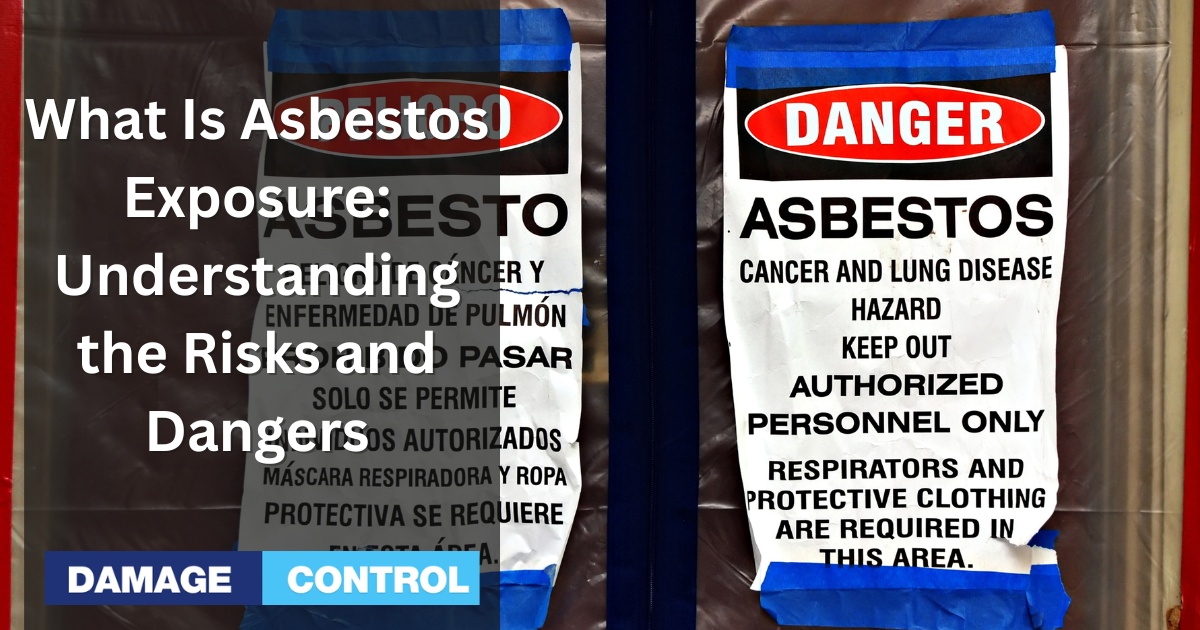Have you ever heard of asbestos exposure? It's a topic that has gained attention in recent years due to the harmful effects it can have on human health. Asbestos is a naturally occurring mineral that was commonly used in construction materials, such as insulation, roofing, and flooring, in the 20th century.
However, exposure to asbestos fibers can lead to serious health problems, including lung cancer, mesothelioma, and asbestosis.
Asbestos exposure occurs when asbestos fibers are inhaled or swallowed, and they become lodged in the lungs or digestive system. The fibers are too small to see with the naked eye, and people may not realize they have been exposed until years later when symptoms start to appear.
The risk of developing asbestos-related diseases increases with the amount and duration of exposure, as well as other factors such as smoking and age.
It's important to understand the risks of asbestos exposure and take steps to protect yourself and your loved ones. In this article, we will explore what asbestos is, how people are exposed to it, the health effects of exposure, and what you can do to minimize your risk.
Whether you work in a high-risk industry or want to learn more about this important topic, we hope this article will provide you with valuable information and insights.
What is Asbestos Exposure?
Asbestos is a group of naturally occurring minerals composed of thin, needle-like fibers. It has been used for decades in various industries due to its heat-resistant and durable properties. The six types of asbestos are chrysotile, crocidolite, amosite, anthophyllite, tremolite, and actinolite. Asbestos exposure can lead to serious health problems, including lung cancer, mesothelioma, and asbestosis.
How Asbestos Exposure Occurs
Asbestos exposure occurs when microscopic asbestos fibers become airborne and are inhaled or ingested. This can happen when asbestos-containing materials are disturbed, damaged, or deteriorated. Some of the most common ways people are exposed to asbestos include working in industries such as construction, shipbuilding, and manufacturing, as well as living or working in buildings containing asbestos-containing materials.
Types of Asbestos
The three most commonly used types of asbestos are chrysotile, amosite, and crocidolite. Chrysotile is the most common type of asbestos and was used in a variety of products, including insulation, roofing materials, and brake pads. Amosite was commonly used in insulation and cement products, while crocidolite was used in some insulation products and was also known as blue asbestos due to its blue-gray color.
Other types of asbestos include anthophyllite, tremolite, and actinolite. These types of asbestos are less commonly used in commercial products but can still pose a health risk if they are disturbed and become airborne.
Health Risks Associated with Asbestos Exposure

What is Asbestosis?
Asbestosis is a chronic lung disease caused by inhaling its fibers. These fibers build up in the lungs and cause scarring, leading to breathing difficulties and other health problems. Asbestosis symptoms include shortness of breath, chest pain, and a persistent cough. While there is no cure for asbestosis, treatments can help manage symptoms and slow the progression of the disease.
What is Lung Cancer?
Lung cancer is a type of cancer that starts in the lungs and can spread to other parts of the body. Asbestos exposure is a known risk factor for lung cancer, especially in people who smoke. Symptoms of lung cancer include a persistent cough, chest pain, and difficulty breathing. Treatment options for lung cancer include surgery, chemotherapy, and radiation therapy.
What is Mesothelioma?
Mesothelioma is a rare form of cancer that affects the lining of the lungs, chest, abdomen, or heart. Asbestos exposure is the primary cause of mesothelioma, with symptoms often not appearing until decades after exposure. Symptoms of mesothelioma include chest pain, shortness of breath, and coughing up blood. Unfortunately, there is currently no cure for mesothelioma, but treatments can help manage symptoms and extend life expectancy.
Asbestos exposure can lead to a variety of serious health risks, including asbestosis, lung cancer, and mesothelioma. Protecting yourself from asbestos exposure is important, especially if you work in an industry that may put you at risk. If you have been exposed to asbestos, it's important to talk to your healthcare provider about steps you can take to manage your risk and protect your health.
Occupations at Risk of Asbestos Exposure

Asbestos exposure can happen to anyone who comes into contact with the substance, but some occupations have a higher risk than others because it's often hidden in plain sight. Here are some of the occupations that are at risk of asbestos exposure:
Construction Workers
Construction workers are at high risk of asbestos exposure because asbestos was commonly used in building materials such as insulation, roofing, and flooring. Workers who perform renovations, repairs, or demolition work on older buildings are especially at risk.
Shipbuilders and Navy Personnel
Asbestos was widely used in shipbuilding due to its heat-resistant properties. Shipbuilders and Navy personnel who worked on ships built before the 1970s are at risk of asbestos exposure.
Mechanics
Mechanics who work on older cars and trucks may be exposed to asbestos through brake pads, gaskets, and other parts that contain asbestos.
Firefighters
Firefighters may be exposed to asbestos when they enter burning buildings containing asbestos insulation or other materials.
Electricians
Electricians who work in older buildings may be exposed to asbestos through electrical wiring insulation that contains asbestos.
Teachers
Teachers may be exposed to asbestos if they work in older school buildings that contain asbestos insulation or other asbestos-containing materials.
Factory Workers
Factory workers may be exposed to asbestos if they work in factories that produce asbestos-containing products or use asbestos-containing materials in their manufacturing processes.
Workers in these occupations need to take precautions to minimize their risk of asbestos exposure. Employers should also provide training and protective gear to workers at risk of asbestos exposure.
Regulations and Guidelines for Asbestos Exposure
What are the Occupational Safety and Health Administration (OSHA) Regulations for Asbestos Exposure?
OSHA has established regulations to protect workers from exposure to asbestos in the workplace. The regulations require employers to identify asbestos-containing materials and to protect workers from exposure. The regulations also establish exposure limits for asbestos and require employers to provide training to workers who may be exposed to asbestos.
The OSHA regulations apply to all industries covered by the Occupational Safety and Health Act, except for construction work. The regulations require employers to provide protective equipment and clothing to workers who may be exposed to asbestos. Employers must also offer medical examinations for workers exposed to asbestos.
What are the Environmental Protection Agency (EPA) Guidelines for Asbestos Exposure?
The EPA has established guidelines to protect the public from asbestos exposure. The guidelines address the use, handling, and disposal of asbestos-containing materials. The guidelines also establish standards for the cleanup of asbestos-contaminated sites.
The EPA guidelines prohibit the use of asbestos in most products. The guidelines require schools to inspect buildings for damaged asbestos and to eliminate or reduce asbestos exposure to occupants. The guidelines also require contractors to follow specific procedures when removing asbestos-containing materials from buildings.
In addition to the OSHA and EPA guidelines, many states have established regulations to protect workers and the public from asbestos exposure. These regulations may be more stringent than the federal regulations and guidelines.
Asbestos Exposure Prevention and Control

What Personal Protective Equipment (PPE) is Necessary?
Personal Protective Equipment (PPE) is essential when working with asbestos-containing materials. The type of PPE needed depends on the level of exposure and the type of asbestos-containing materials being handled. Some examples of PPE include:
- Respirators
- Protective clothing
- Gloves
- Eye protection
It is important to ensure the PPE is properly fitted and in good condition before use. Training on properly using and disposing PPE is also necessary to ensure that workers are protected from exposure.
What is Asbestos Abatement and Removal?
Asbestos abatement and removal eliminate asbestos-containing materials from buildings and structures. These processes require specialized equipment and trained professionals to safely remove the materials without releasing asbestos fibers into the air.
Before any removal or abatement work can begin, an asbestos survey must be conducted to identify the location and type of asbestos-containing materials present. The area must be sealed off and negative air pressure established to prevent the spread of asbestos fibers.
Once the materials are removed, they must be properly disposed of in accordance with local and federal regulations. Hiring licensed and certified professionals for asbestos abatement and removal is important to ensure that the work is done safely and effectively.
Conclusion
We've uncovered the hazards of asbestos exposure, delving into its risks and implications. It's vital to remember that understanding these dangers is our first step towards mitigating potential health threats. Being aware allows us to create safer environments, free from the harmful reach of asbestos. Let's continue to leverage our knowledge, advocate for health, and strive for a future where the threats posed by asbestos exposure are a thing of the past. Here's to fostering safer, healthier spaces for all of us to thrive.

